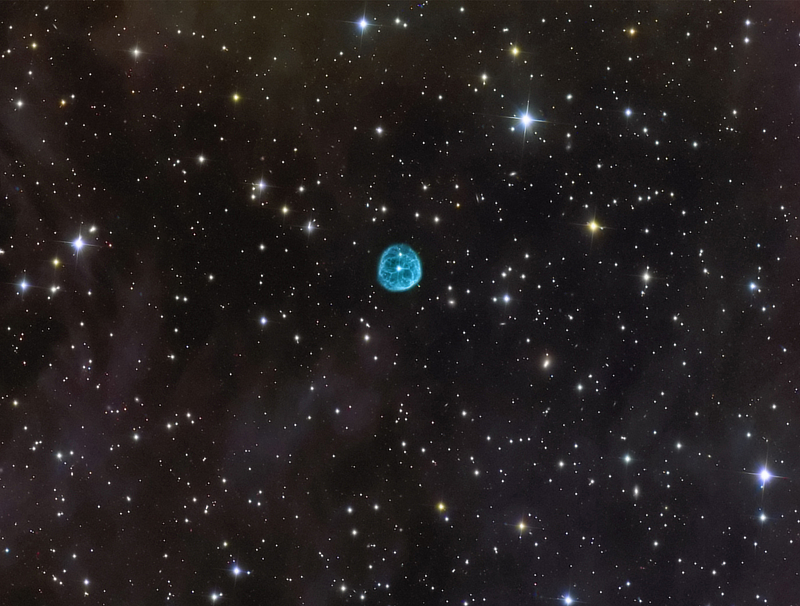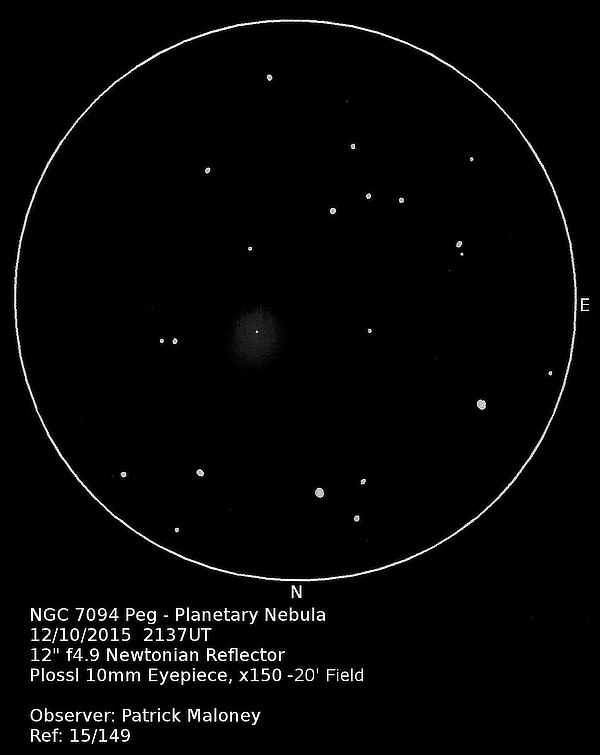NGC 7094 in Pegasus
August 2024 - Nebula and Cluster of the Month
During August, we get a full return to astronomical dark, with darkness lasting about an hour and a half at the beginning of the month and extending to nearly six hours by the end. This is the time to get back out under the sky and begin enjoying observing again.
Along with the increasing darkness, the autumnal constellations begin to make their presence known in the east, rising to prominence by the end of the month.
This month's object is a challenge and a test of your sky conditions. I will demonstrate my own attempts (ultimately successful) to see this object.
For once, this object was not discovered (or even seen) by William Herschel, which gives an indication of its difficulty.
NGC 7094 was discovered by Lewis Swift, a discoverer of deep-sky objects second only to the Herschels, with 1,248 new objects plus 13 comets to his name.
He first saw what was later to be catalogued as NGC 7094 on 10 October 1884. He described it as Nebulous star. Bright star; in most extremely faint nebulosity; very difficult; nearly pointed to by 3 stars in a line
. It was first published in his second catalogue, under the designation Sw II 88. The object was included in the NGC four years later, with the description remaining materially unchanged, if a little briefer: star in most extremely faint nebulosity, very difficult.
To be honest, this object is very difficult, but not impossible, as I will show.

NGC 7094 is a planetary nebula, situated 1.8° east-north-east of the bright globular cluster M15 in Pegasus. It lies against a background of extensive nebulosity labelled LBN 152, though this is not visible without long exposures. The planetary’s Vorontsov-Velyaminov classification is IV, indicating annularity, although the ring structure in it is fairly weak.
In The Night Sky Observer’s Guide: Volume 1 – Autumn & Winter by Kepple and Sanner, the description of the nebula through a 12-14” telescope (there is no observation from a smaller scope) says [NGC 7094] is a very faint, round, uniform glow surrounding a 13.7 magnitude star.
In his Visual Observations of Planetary Nebulae, Kent Wallace includes an observation of this object made with an 8” SCT. He describes it at x62.5 as a ...faint, large disc, requiring the OIII filter and averted vision.
At x100, it is clearer but still needs the filter and averted vision.
My own quest to observe this object started in July 2014 when, towards the end of an observing session from home, I noticed the planetary nebula close to M15 on the chart for the region I had been observing in. I brought up a chart showing stars to 15th magnitude and positively identified the field I was looking at from that. Even with an OIII filter in place and the use of averted vision, I could not see the object.
I looked again on 5 August of that year. This time I wrote in my journal Faintly glimpsed at x83 with the OIII filter in place. Lost again. Later barely suspected at x150 with the OIII. I have to record this as not seen.
In September, I tried a third time to spot the object, this time from a dark-sky site in the Lake District. I had a little more success this time, but the view was impaired by the atmospheric conditions, which I described as Very wet. Very heavy dew, mist making bright torch beams. Otherwise quite good. Milky Way visible horizon to horizon. Mild. No wind.
My description of the object on that night was Extremely faint but quite large. A very dim aura of nebulosity around a faint star. The OIII filter does nothing except render the object quite invisible.
The reaction to the OIII filter was quite the opposite of what I expected.
Thus the matter stood for over a year, until October of 2015, when from the same dark-sky site, I tried for a fourth time. This time I met with much more success. The air was a lot drier and made the stars much crisper than they had been on the previous attempt. This time, I wrote Quite large and immediately visible at x81, but very dim. Round, smooth, quite circular grey disc. Totally invisible with the OIII filter. Bright central star (magnitude 13.7).

I don’t know what was different between my observations and Kent Wallace’s. My observations were all made with the same 12” Newtonian, and his with an 8” SCT. Why the OIII filter should be necessary for him to see it but render the object quite invisible to me is a mystery. I have always found the OIII filter to be an essential piece of kit when looking at planetary nebulae. Sometimes, however, when the object is just too dim, the elimination of any light (which is what a filter does) is too much and renders the object invisible.
As a further test of your sky conditions and equipment, there is a second star superimposed on the disc of the nebula, clearly seen in the image above. This star is 16th magnitude and is too faint for my 12” telescope.
| Object | RA | Dec | Type | Magnitude |
|---|---|---|---|---|
| NGC 7094 | 21h 36m 53s | +12° 47’ 13” | Planetary nebula | 13.4 |